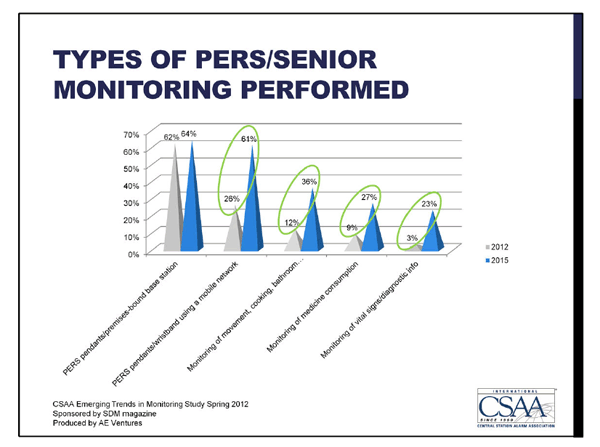Under the sponsorship of SDM, the Education Committee of the Central Station Alarm Association sought to examine current and planned involvement of security central stations in different types of monitoring, with a special focus on video monitoring and PERS and senior monitoring. In those three areas in particular, the survey sought to understand the obstacles to more aggressive adoption. We also wanted to learn more about what could be done to help industry participants advance in these areas and make better business decisions about their level of involvement going forward.
The survey results that follow illustrate that there are indeed certain categories within the monitoring business that seem to be primed for dramatic growth. In addition, the survey also highlights particular obstacles that may stand in the way of that growth occurring.
Our method was to develop an online survey for industry members to offer their perspectives about their current monitoring services versus where they saw their business/monitoring focus in three short years (by 2015). AE Ventures’ President John Galante managed this research project and developed a 26-question survey with inputs from subject matter experts, including John Brady of TRG Associates, John Lombardi of CIA Security and Joe Miskulin of State Farm, and CSAA Director of Education, Stephanie Morgan.
First, a look at the primary business of the survey’s respondents. Roughly two-thirds of respondents both install and monitor security. Sixteen percent provide monitoring only and 9 percent are proprietary central stations.
Most importantly, all of the respondents included in the results monitor customer accounts; therefore, supplier responses or others that do not operate a central station do not skew the data. The survey yielded 148 responses, which gives a reasonable level of statistical significance to the results.
A little more definition about the businesses that make up the survey results:
- The vast majority are UL listed or certified central stations in some way.
- Almost four out of five responding companies monitor 5,000 or more accounts.
- Better than a quarter monitor 50,000 or more accounts.

|
The respondents are spread around the United States with some emphasis in the Northeast and Midwest.

|
The study illustrates the percentage of companies performing various types of monitoring currently in 2012 and where they see themselves headed by 2015.

|
The study confirms that while there are increasingly high rates of involvement in a variety of forms of monitoring, the majority of monitoring revenues today (nearly 80 percent) continue to be associated with traditional intrusion and fire alarms. That picture is changing, with video-verified alarms and categories such as PERS, managed video and managed access increasing share over the next three years; but even in 2015, the responding companies project roughly two-thirds of monitoring revenues still will be traditional intrusion and fire alarm.

|
With the average monitoring contract at roughly five years, it seems that the majority of the participants believe that it will be a while before the revenue effects of the newer forms of monitoring revenue associated with new installations and upgrades will make a more substantial dent in overall monitoring revenue share.
So let’s dig in a bit on our two focus areas — video monitoring and PERS and senior monitoring. First on video monitoring, here is a look at the status of responding companies with regard to video monitoring:
- 61 percent are involved at some level, with another 23 percent wanting to become involved in the next two years.
- Only 16 percent are not involved and have no plans to be.
- Roughly one-third are at an early stage of involvement, and one-quarter are well established.
- Almost one-third of those involved at some level are planning substantial or dramatic growth in the next few years.

|
Here’s a look at current and planned involvement in a few video monitoring applications.
We were surprised to see the high current level of involvement in the non-security customer service and retail floor analysis category.
And it looks like there will be strong growth for the idea of offering reception and door control services through video monitoring in the future.

|
So what is holding monitoring companies back from more aggressively adopting and offering video monitoring?
Top of the list is lack of demand. This category is still very new. The offers to end-users are being sorted out. Integrators are still figuring out their pitches. This is a pretty massive conversion from the days when video systems were sold for proprietary operation and control only and were part of the capital expenditures budgets. Those buying patterns and habits are not going to change overnight, so it seems like a pretty legitimate data point that lack of demand is the top inhibitor for video monitoring investments by central stations.
On the other hand, there is a “chicken and the egg” situation here. You can’t always wait for the demand to come to you. Sometimes you need to invest in creating the demand. I suspect finding the right balance and timing of that investment ranks high in the mind of central station owners and leaders.
Now let’s turn to PERS and senior monitoring.
Here’s a look at the status of responding companies with regard to PERS/senior monitoring:
- 65 percent are involved at some level, with another 9 percent looking to become involved in the next two years.
- 26 percent are not involved and have no plans to do so. That’s higher than what we saw with video, probably because a higher percentage of integrators don’t do residential business, which is where PERS and senior monitoring are confined.
- Approximately one-fifth of respondents are at an early stage of involvement, and more than one-third are well-established.
- More than one-third of those involved at some level are planning substantial or dramatic growth in the next few years.

|
Below is a look at current and planned involvement in a number of specific PERS and senior monitoring technologies and applications.
It looks like we’re going to be seeing dramatic growth in systems that leverage the mobile communications network rather than (or in addition to) premises-bound base units.
It seems like a number of companies are acting on the opportunity to provide more comprehensive senior monitoring including tracking movement, cooking and bathroom activities; monitoring medicine consumption; and monitoring life signs and other diagnostic information.

|
The headline to this survey is that the “Other Senior Monitoring” category seems to be the one most primed for dramatic growth. For PERS and senior monitoring, lack of demand also tops the list, but liability is a much higher concern than what we saw in video.
You can see the differences clearly in the results below. The liability aspects are a stronger inhibitor in PERS and senior monitoring, likely due to the fact that the client population is more inclined to accident and death and those are higher potential triggers to legal action. For video there seems to be much larger technical and procedural questions to answer.

|
The next survey in this Educational Series will focus on technology and human investments to explore how they intersect and are managed by those in the industry today.
About the Author: John Brady is president of TRG Associates Inc., Old Saybrook, Conn. John established The Resource Group, Inc. in 1991 and transferred the Security Group to TRG Associates, Inc. in 1994. Since its inception, TRG has assisted a wide range of companies, entrepreneurs, lenders, and investors in evaluating and assimilating acquisitions and with the placement of debt/equity within the electronic security industry. TRG has assisted companies in excess of over 300 due diligences, implementing ongoing operational improvements, completed a number of business valuation assessments on behalf of owners, equity holders and financial institutions throughout the United States.


